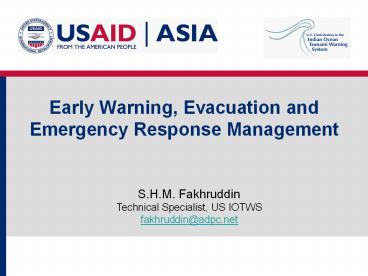Early Warning, Evacuation and Emergency Response Management PowerPoint PPT Presentation
Title: Early Warning, Evacuation and Emergency Response Management
1
Early Warning, Evacuation and Emergency Response
Management
S.H.M. Fakhruddin Technical Specialist, US
IOTWS fakhruddin_at_adpc.net
2
Elements of Coastal Community Resilience
3
The Warning System
- Detection / Warning - Dissemination -
Response
4
Warning Evacuation System Goal
To maximize the number of people who take
appropriate and timely action to minimize injury,
death, and property damage due to hazards
5
Features of Early Warning
- A System Design and Plan including regulatory
framework for involved agencies, decision
authorities, mapping of communications, required
training for personnel, SOPs, Checklists, and
Testing Protocols at all levels of government - Technology and Hardware for disseminating
warnings - Plan and Conduct of routine tests, simulation
exercise and evaluation of total system on
regular basis
6
Features of Evacuation
- Identifying Evacuation place and develop maps,
plans with community engagement and proper
signage for safe evacuation - Local authorities Community is responsible to
issue evacuation orders and ensure that warnings
can be accessible to, understood by, and acted
upon by local populations under their
jurisdictions
7
Factors Considered in a Resilient Warning System
- Targeting populations-at-risk, communication for
warning must take into account - Who are the recipients
- Where they are located
- What they are doing
- Time of day.
- Season (e.g., peak tourist season)
- what they rely upon to receive local news and
information - what special needs they may have, and
- how well they understand and accept the warning
in order to take action.
8
Communication Technologies for Warning and
Evacuation Order
- Broadcasting systems
- Tsunami Warning Towers/ ICT Tower
- Announcement Tower/ Loud Speakers
- Provincial radio broadcasting
- Amateur radio
- VHF/HF radios
- Police Car/ Micro phone, mosque, temple
- Indigenous (e.g.. bamboo stick, Drum beating)
- Telecommunication systems
- Land line phone
- SMS/ Mobile
- Fax
- Inter personal communication
- Door-to-door
9
Good Practices..
- PTWC AND HAWAII AS EXAMPLE OF END-TO-END SYSTEM
- HAWAII did Tsunami Hazard Assessments in the
1970s and continue to update - Tsunami Evacuation Zones Published in Telephone
Books - Public Education Programs in Place including a
Tsunami Awareness Month - State and Counties Receive PTWC Bulletins by
Multiple Means - Public is Notified by Multiple Means Sirens,
Radio, Television, Airplanes
10
Good Practices..
- PTWC AND HAWAII AS EXAMPLE OF END-TO-END SYSTEM
- Counties Participate in NWS Tsunami-ready Program
- State Conducts Semi-annual Tsunami Exercises
- State and Counties Have Pre-established
Procedures For Carrying out Tsunami Evacuations
and Response with Police, Fire, and Other
Departments
11
Good Practices..
- PTWC AND HAWAII AS EXAMPLE OF END-TO-END SYSTEM
- State Organizes and Holds Semi-annual
Stakeholders Meetings of its Tsunami Technical
Review Committee that Includes PTWC, Emergency
Managers, Emergency Responders, And Scientists - State of Hawaii and its Counties have Experts
that Serve as Tsunami Advisors - Hawaii Participates In The U.S. National Tsunami
Hazard Mitigation Program
12
Emergency Response
- All emergencies and crisis events are by
definition chaotic and highly dynamic, creating
physical, emotional, and social disorder. - Normally, EOC manages the emergency response
effort comprising of command, control and
coordination of organizations and resources.
13
Key Features of Emergency Response
- Clear objectives and priorities
- Defined operational objectives and organization
- Action Plan
- Objectives and Priorities Organization Chart
- Tactical Assignments Medical Plan
- Communication Plan Air Operations Plan
- Weather Safety
- Travel Routes/Maps
- Common terminology
14
Key Features of Emergency Response
- Common communications
- Uniform resource typing
- Written Position Descriptions
- Roles and responsibilities defined
- Clear lines of authority, chain of command and
reporting requirements - Standardized personnel qualifications and
training national coordinating group
15
Good Practices Incident Command System (ICS)
- Single standardized incident management system
used by all emergency response disciplines - Multi-hazard disaster response leadership
structure for COMMAND AND MANAGEMENT specific
technical competency skills are integrated in the
ICS organization - Provides accurate information, strict
accountability, planning, and cost effective
operations and logistical support for any incident
16
ICS in Asia
- India
- Ongoing since 2002
- Ministry of Home Affairs focal point
- LBSNAA Indian Administrative Service training
institution - ASEAN
- On-going since 2004
- ASEAN Committee on Disaster Mgmt focal point
- Regional application
- Pilot countries Brunei, Philippines, Vietnam
- Sri Lanka
17
Thank You
An effective warning, Evacuation and Emergency
Response system always requires continuous public
education and awareness about the purpose and
capabilities of the system. A system can never be
totally effective without education, no matter
how expensive or sophisticated. Whatever methods
are chosen, all groups that are part of the
warning process should be involved in the
planning, implementation and operation of their
systems.

